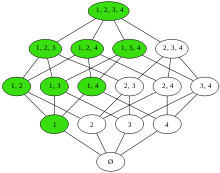Upper set
In mathematics, an upper set (also called an upward closed set or an upset) of a partially ordered set (X, ≤) is a subset U of X such that if x is in U and x ≤ y, then y is in U. That is, U satisfies the property

The dual notion is a lower set (also called a downward closed set, down set, decreasing set, initial segment, or semi-ideal), which is a subset L of X such that that if x is in L and y ≤ x, then y is in L, i.e.
The terms order ideal or ideal are sometimes used as synonyms for lower set.[1][2][3] This choice of terminology fails to reflect the notion of an ideal of a lattice because a lower set of a lattice is not necessarily a sublattice.[1]
Properties
- Every partially ordered set is an upper set of itself.
- The intersection and the union of upper sets is again an upper set.
- The complement of any upper set is a lower set, and vice versa.
- Given a partially ordered set (X, ≤), the family of upper sets of X ordered with the inclusion relation is a complete lattice, the upper set lattice.
- Given an arbitrary subset Y of a partially ordered set X, the smallest upper set containing Y is denoted using an up arrow as ↑Y (see upper closure and lower closure).
- Dually, the smallest lower set containing Y is denoted using a down arrow as ↓Y.
- A lower set is called principal if it is of the form ↓{x} where x is an element of X.
- Every lower set Y of a finite partially ordered set X is equal to the smallest lower set containing all maximal elements of Y: Y = ↓Max(Y) where Max(Y) denotes the set containing the maximal elements of Y.
- A directed lower set is called an order ideal.
- The minimal elements of any upper set form an antichain.
- Conversely any antichain A determines an upper set {x: x ≥ y for some y in A}. For partial orders satisfying the descending chain condition this correspondence between antichains and upper sets is 1-1, but for more general partial orders this is not true.
Upper closure and lower closure
Given an element x of a partially ordered set (X, ≤), we define the upper closure of x, denoted by ↑x, as ↑x = {y∈X : x≤y}, and the lower closure of x, denoted by ↓x, as ↓x = {y∈X : y≤x}. One can show that ↑x and ↓x are the smallest upper and lower sets containing x, respectively. More generally, given a subset A of X we define the upper and lower closures of A, denoted by ↑A and ↓A respectively, as and . In this way we have ↑x = ↑{x} and ↓x = ↓{x}, and upper sets and lower sets of this form are called principal. Similarly, one can show that the upper and lower closures of a set are the smallest upper and lower sets containing it.
The upper and lower closures, when viewed as function from the power set of X to itself, are examples of closure operators since they satisfy all of the Kuratowski closure axioms. As a result, the upper closure of a set is equal to the intersection of all upper sets containing it, and similarly for lower sets. Indeed, this is a general phenomenon of closure operators. For example, the topological closure of a set is the intersection of all closed sets containing it; the span of a set of vectors is the intersection of all subspaces containing it; the subgroup generated by a subset of a group is the intersection of all subgroups containing it; the ideal generated by a subset of a ring is the intersection of all ideals containing it; and so on.
One can also speak of the strict upper closure of an element x in X defined as {y∈X : x<y}, and more generally, the strict upper closure of a subset A of X which is defined as the union of the strict upper closures of its elements, and we can make analogous definitions for strict lower closures. However note that these 'closures' are not actually closure operators, since for example the strict upper closure of a singleton set {x} does not contain {x}.
Ordinal numbers
An ordinal number is usually identified with the set of all smaller ordinal numbers. Thus each ordinal number forms a lower set in the class of all ordinal numbers, which are totally ordered by set inclusion.
See also
- Cofinal set – a subset U of a partially ordered set (X, ≤) that contains for every element x of X an element y such that x ≤ y
References
- Brian A. Davey; Hilary Ann Priestley (2002). Introduction to Lattices and Order (2nd ed.). Cambridge University Press. ISBN 0-521-78451-4. LCCN 2001043910. Here: p. 20 and 44.
- Stanley, R.P. (2002). Enumerative combinatorics. Cambridge studies in advanced mathematics. 1. Cambridge University Press. p. 100. ISBN 978-0-521-66351-9.CS1 maint: ref=harv (link)
- Lawson, M.V. (1998). Inverse semigroups: the theory of partial symmetries. World Scientific. p. 22. ISBN 978-981-02-3316-7.CS1 maint: ref=harv (link)
- Blanck, J. (2000). "Domain representations of topological spaces" (PDF). Theoretical Computer Science. 247: 229–255. doi:10.1016/s0304-3975(99)00045-6.
- Hoffman, K. H. (2001), The low separation axioms (T0) and (T1)
- Davey, B.A. & Priestley, H. A. (2002). Introduction to Lattices and Order (2nd ed.). Cambridge University Press. ISBN 0-521-78451-4.